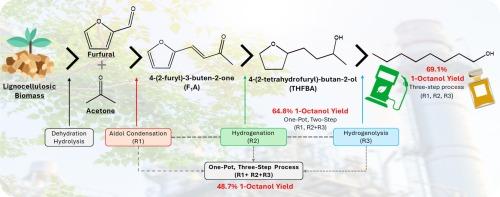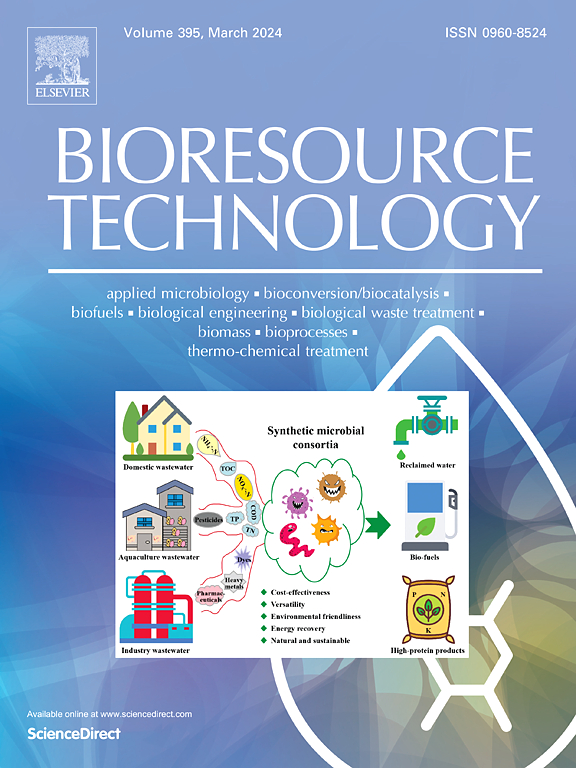在多功能酸基催化体系上,将糠醛和丙酮进行单锅顺序醛醇缩合和加氢脱氧生成 1-辛醇。
IF 9
1区 环境科学与生态学
Q1 AGRICULTURAL ENGINEERING
引用次数: 0
摘要
糠醛和丙酮是从木质纤维素生物质中提取的两种最有前景的化学品。将这两种化合物结合在一起,可以从生物质中提取更多的高附加值化学品。在本研究中,通过一系列反应:醛醇缩合(R1)、氢化(R2)和氢解(R3),从糠醛和丙酮制得了 1-辛醇(一种很有前景的中链长醇)。对每个步骤都进行了单独研究,以了解其机理和要求,从而能够无缝集成到单锅两步法(R1、R2 + R3)和单锅三步法(R1 + R2 + R3)工艺中。为了促进这些反应,合成了基于氧化铝-氧化锆的双功能催化剂。此外,为了提高 1-辛醇的产率,还在反应中加入了固体酸性添加剂,特别是磺酸功能化二氧化硅(KCC-1-APSO3H)。三步法(R1、R2、R3)的 1-辛醇产率最高(69.1%),其次是单锅两步法(R1、R2 + R3,64.8%),以及使用 Ni/Al2O3-ZrO2 和 KCC-1-APSO3H 组合催化剂的单锅三步法(R1 + R2 + R3,48.7%)。在所有研究的工艺中,单锅两步法是兼顾工艺整合效率和 1-辛醇产量的最佳方法。本研究为开发从生物质中生产线性醇的催化方法提供了宝贵的见解。本文章由计算机程序翻译,如有差异,请以英文原文为准。

One-pot sequential aldol condensation and hydrodeoxygenation of furfural and acetone to 1-octanol over multifunctional acid-based catalytic system
Furfural and acetone are two of the most promising chemicals derived from lignocellulosic biomass. Coupling these two compounds expands the broad range of value-added chemicals that can be derived from biomass. In this study, 1-octanol, a promising medium chain-length alcohol, was produced from furfural and acetone through a series of reactions: aldol condensation (R1), hydrogenation (R2), and hydrogenolysis (R3). Each step was individually investigated to understand its mechanism and requirements, enabling seamless integration into one-pot, two-step (R1, R2 + R3) and one-pot, three-step (R1 + R2 + R3) processes. To facilitate these reactions, bifunctional alumina–zirconia-based catalysts were synthesized. Additionally, to enhance the yield of 1-octanol, solid acidic additives, particularly sulfonic acid-functionalized silica (KCC-1-APSO3H), were incorporated into the reaction. The highest yield of 1-octanol (69.1 %) was achieved with the three-step process (R1, R2, R3), followed by the one-pot, two-step process (R1, R2 + R3, 64.8 %), and the one-pot, three-step process (R1 + R2 + R3, 48.7 %) using the combined Ni/Al2O3-ZrO2 and KCC-1-APSO3H catalyst. Among all the processes investigated, the one-pot, two-step process emerged as the best approach balancing the efficiency of the process integration and 1-octanol yield. The present study offers valuable insights into the development of catalytic methods for producing linear alcohols from biomass.
求助全文
通过发布文献求助,成功后即可免费获取论文全文。
去求助
来源期刊

Bioresource Technology
工程技术-能源与燃料
CiteScore
20.80
自引率
19.30%
发文量
2013
审稿时长
12 days
期刊介绍:
Bioresource Technology publishes original articles, review articles, case studies, and short communications covering the fundamentals, applications, and management of bioresource technology. The journal seeks to advance and disseminate knowledge across various areas related to biomass, biological waste treatment, bioenergy, biotransformations, bioresource systems analysis, and associated conversion or production technologies.
Topics include:
• Biofuels: liquid and gaseous biofuels production, modeling and economics
• Bioprocesses and bioproducts: biocatalysis and fermentations
• Biomass and feedstocks utilization: bioconversion of agro-industrial residues
• Environmental protection: biological waste treatment
• Thermochemical conversion of biomass: combustion, pyrolysis, gasification, catalysis.
 求助内容:
求助内容: 应助结果提醒方式:
应助结果提醒方式:


